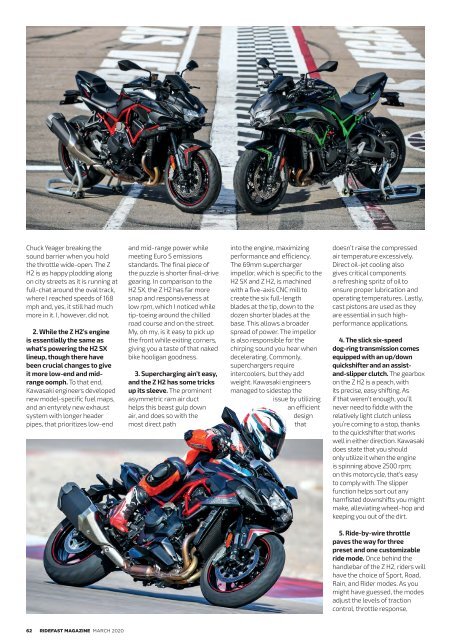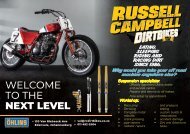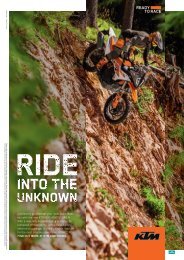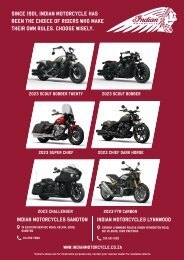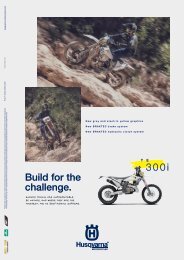Create successful ePaper yourself
Turn your PDF publications into a flip-book with our unique Google optimized e-Paper software.
Chuck Yeager breaking the<br />
sound barrier when you hold<br />
the throttle wide-open. The Z<br />
H2 is as happy plodding along<br />
on city streets as it is running at<br />
full-chat around the oval track,<br />
where I reached speeds of 168<br />
mph and, yes, it still had much<br />
more in it. I, however, did not.<br />
2. While the Z H2’s engine<br />
is essentially the same as<br />
what’s powering the H2 SX<br />
lineup, though there have<br />
been crucial changes to give<br />
it more low-end and midrange<br />
oomph. To that end,<br />
Kawasaki engineers developed<br />
new model-specific fuel maps,<br />
and an entyrely new exhaust<br />
system with longer header<br />
pipes, that prioritizes low-end<br />
and mid-range power while<br />
meeting Euro 5 emissions<br />
standards. The final piece of<br />
the puzzle is shorter final-drive<br />
gearing. In comparison to the<br />
H2 SX, the Z H2 has far more<br />
snap and responsiveness at<br />
low rpm, which I noticed while<br />
tip-toeing around the chilled<br />
road course and on the street.<br />
My, oh my, is it easy to pick up<br />
the front while exiting corners,<br />
giving you a taste of that naked<br />
bike hooligan goodness.<br />
3. Supercharging ain’t easy,<br />
and the Z H2 has some tricks<br />
up its sleeve. The prominent<br />
asymmetric ram air duct<br />
helps this beast gulp down<br />
air, and does so with the<br />
most direct path<br />
into the engine, maximizing<br />
performance and efficiency.<br />
The 69mm supercharger<br />
impellor, which is specific to the<br />
H2 SX and Z H2, is machined<br />
with a five-axis CNC mill to<br />
create the six full-length<br />
blades at the tip, down to the<br />
dozen shorter blades at the<br />
base. This allows a broader<br />
spread of power. The impellor<br />
is also responsible for the<br />
chirping sound you hear when<br />
decelerating. Commonly,<br />
superchargers require<br />
intercoolers, but they add<br />
weight. Kawasaki engineers<br />
managed to sidestep the<br />
issue by utilizing<br />
an efficient<br />
design<br />
that<br />
doesn’t raise the compressed<br />
air temperature excessively.<br />
Direct oil-jet cooling also<br />
gives critical components<br />
a refreshing spritz of oil to<br />
ensure proper lubrication and<br />
operating temperatures. Lastly,<br />
cast pistons are used as they<br />
are essential in such highperformance<br />
applications.<br />
4. The slick six-speed<br />
dog-ring transmission comes<br />
equipped with an up/down<br />
quickshifter and an assistand-slipper<br />
clutch. The gearbox<br />
on the Z H2 is a peach, with<br />
its precise, easy shifting. As<br />
if that weren’t enough, you’ll<br />
never need to fiddle with the<br />
relatively light clutch unless<br />
you’re coming to a stop, thanks<br />
to the quickshifter that works<br />
well in either direction. Kawasaki<br />
does state that you should<br />
only utilize it when the engine<br />
is spinning above 2500 rpm;<br />
on this motorcycle, that’s easy<br />
to comply with. The slipper<br />
function helps sort out any<br />
hamfisted downshifts you might<br />
make, alleviating wheel-hop and<br />
keeping you out of the dirt.<br />
5. Ride-by-wire throttle<br />
paves the way for three<br />
preset and one customizable<br />
ride mode. Once behind the<br />
handlebar of the Z H2, riders will<br />
have the choice of Sport, Road,<br />
Rain, and Rider modes. As you<br />
might have guessed, the modes<br />
adjust the levels of traction<br />
control, throttle response,<br />
62 RIDEFAST MAGAZINE MARCH <strong>2020</strong>


